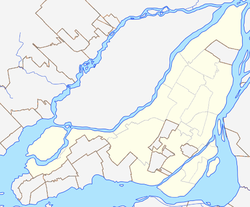This article needs to be updated.(May 2017) |
| Cabot Square | |
|---|---|
 The monument to John Cabot in Cabot Square. | |
| Type | Town square |
| Location | Shaughnessy Village, Ville-Marie Montreal, Quebec, Canada |
| Coordinates | 45°29′22″N73°35′01″W / 45.489444°N 73.583611°W |
| Area | 0.61 hectares (1.5 acres) |
| Created | 1870 |
| Operated by | City of Montreal |
| Status | Open all year |
| Public transit access | |
Cabot Square is an urban square in Montreal, Quebec, Canada between the former Montreal Forum and the former Montreal Children's Hospital. The square is in the Shaughnessy Village neighbourhood, an area recently re-dubbed the Quartier des Grands Jardins and has been slated for redevelopment. [1]
Contents
It is one of three statues of John Cabot in Canada; the others are both in Newfoundland at Confederation Building in St. John's and Cape Bonavista. Two other statues of Cabot are both found in Bristol, England, at Council House and Bristol Harbour.
